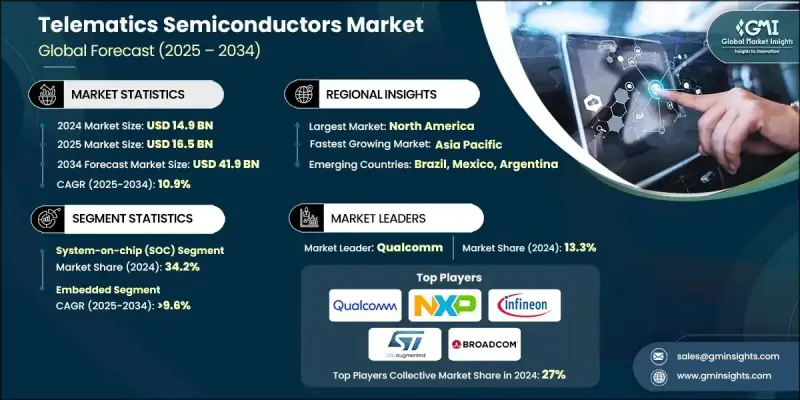
|
시장보고서
상품코드
1844254
텔레매틱스 반도체 시장 : 시장 기회 및 촉진요인, 산업 동향 분석, 예측(2025-2034년)Telematics Semiconductors Market Opportunity, Growth Drivers, Industry Trend Analysis, and Forecast 2025 - 2034 |
||||||
세계의 텔레매틱스 반도체 시장 규모는 2024년에 149억 달러로 평가되었고, CAGR 10.9%로 성장할 전망이며, 2034년에는 419억 달러에 이를 것으로 추정됩니다.

급성장의 배경에는 커넥티드카 기술의 급증, 텔레매틱스 제어 유닛(TCU)에의 AI 통합, V2X(Vehicle-to-Everything) 통신 시스템의 채용, 임베디드 GNSS 모듈의 보급이 있습니다. 자동차 제조업체는 실시간 추적, 차량 안전 규정 준수, 예측 분석, 무선 업데이트, 보증 최적화 등의 기능을 지원하기 위해 고성능, 에너지 효율적인 텔레매틱스 반도체에 대한 투자를 늘리고 있습니다. 커넥티드 차량 플랫폼과 지능형 교통망이 진화함에 따라 텔레매틱스 칩은 모바일 랜드스케이프 전체의 디지털 변환의 핵심 구성 요소가 되고 있습니다. 자동차 제조업체는 안전 규제 준수, 업무 효율성 향상, 차세대 모빌리티 애즈 서비스 모델을 실현하기 위해 텔레매틱스 기능을 도입하고 있습니다. 안전하고 실시간 데이터 처리와 차량 시스템의 통합성 향상에 대한 수요가 높아짐에 따라 첨단 텔레매틱스 SoC, 저전력 무선 송수신기, 차량용 급 마이크로컨트롤러가 널리 채용되고 있습니다. 이러한 이행은 여러 지역 및 차량 부문에 걸친 스마트 모빌리티 에코시스템과 디지털 차량 라이프사이클 플랫폼의 상승에 의해 더욱 강화되고 있습니다.
| 시장 범위 | |
|---|---|
| 시작 연도 | 2024년 |
| 예측 연도 | 2025-2034년 |
| 시장 규모 | 149억 달러 |
| 예측 금액 | 419억 달러 |
| CAGR | 10.9% |
시스템 온칩(SoC) 솔루션 분야는 34.2%의 점유율을 차지하며, 2025-2034년 CAGR 10.5%의 성장이 전망되고 있습니다. SoC는 프로세싱, 커넥티비티 및 보안 기능을 단일의 소형 솔루션으로 통합할 수 있기 때문에 점점 더 선호되고 있습니다. 아키텍처가 통합되어 성능 향상, 전력 소비 감소, 하드웨어 설치 면적 축소가 가능합니다. 자동차 제조업체는 확장성, 낮은 대기 시간 설계 및 예측 유지보수, 차량 진단, 위치 추적, OTA 펌웨어 업데이트 등의 용도에 대한 실시간 데이터를 처리할 수 있는 능력을 위해 SoC에 주목하고 있습니다. 커넥티드 차량 아키텍처로의 전환이 진행됨에 따라 SoC 기반 텔레매틱스 솔루션에 대한 수요가 더욱 커지고 있습니다.
임베디드 텔레매틱스 분야는 2024년에 55%의 점유율을 차지하였고, 2034년까지의 CAGR은 9.6%로 예상되고 있습니다. 임베디드 솔루션은 공장 설치, 신뢰성, 까다로운 데이터 보호 요구 사항을 준수함으로써 OEM과 대규모 함대 운영자들 사이에서 기세를 늘리고 있습니다. 이러한 통합 모듈은 원활한 추적, 원격 진단, 광범위한 차량 플랫폼 및 지역에 걸친 함대 거버넌스 개선을 가능하게 합니다. 또한 임베디드 텔레매틱스 모듈은 첨단 차량 전자 인프라를 지원하며, 특히 상용차 및 전기자동차 부문에서는 현대 차량 관리에 필수적인 것으로 간주됩니다.
미국의 텔레매틱스 반도체 시장은 83%의 점유율을 차지하며, 2024년에는 45억 달러를 창출했습니다. 미국 시장의 호조는 커넥티드 차량 플랫폼의 급속한 채용, 차량의 안전성과 데이터 투명성에 대한 규제의 중시, 차세대 텔레매틱스 인프라에 대한 급속한 투자에 기인합니다. AI를 탑재한 SoC, V2X 통신 모듈, 임베디드 칩셋의 이용이 증가하여 승용차, 상용차, 전기차 전체의 텔레매틱스의 통합을 촉진하고 있습니다. 미국 시장은 자동차용 반도체 분야의 혁신성, 확장성 및 실시간 연결성을 지속적으로 이끌고 있습니다.
세계 텔레매틱스 반도체 시장의 주요 기업으로는 Qualcomm, MediaTek, Renesas Electronics, STMicroelectronics, Analog Devices, Texas Instruments, Murata Manufacturing, Fibocom Wireless, NXP Semiconductors 및 Infineon Technologies 등이 있습니다. 텔레매틱스 반도체 분야에서 사업을 전개하는 기업은 발판을 굳히기 위해 기술 혁신, 전략적 제휴, 제품 포트폴리오 확충에 주력하고 있습니다. 대부분은 AI 지원 텔레매틱스 기능, 사이버 보안 및 V2X 통신을 지원하도록 조정된 저전력, 고성능 칩셋 개발에 투자하고 있습니다. 자동차 OEM 및 Tier-1 공급업체와의 협업은 차량 플랫폼으로의 통합을 더욱 확실히 하는 데 도움이 됩니다. 각 회사는 또한 설계 주기를 단축하고 실시간 처리 능력을 강화하기 위해 연구개발 활동을 확대하고 있습니다.
목차
제1장 조사 방법
- 시장의 범위 및 정의
- 조사 디자인
- 조사 접근
- 데이터 수집 방법
- 데이터 마이닝 소스
- 세계
- 지역 및 국가
- 기본 추정 및 계산
- 기준연도 계산
- 시장 예측의 주요 동향
- 1차 조사 및 검증
- 1차 정보
- 예보
- 조사의 전제 및 한계
제2장 주요 요약
제3장 업계 인사이트
- 생태계 분석
- 공급자의 상황
- 칩 제조업체
- 연결 및 통신 모듈 제공업체
- 플랫폼 및 소프트웨어 벤더
- 유통업체 및 애그리게이터
- OEM
- 시스템 통합자 및 서비스 제공업체
- 최종 용도
- 이익률 분석
- 각 단계에서의 부가가치
- 밸류체인에 영향을 주는 요인
- 혁신
- 공급자의 상황
- 업계에 미치는 영향요인
- 성장 촉진요인
- 커넥티드카의 급속한 보급
- 안전성 및 규정 준수를 위한 규제 추진
- OEM에 있어서 운용 효율 중시
- OTA 및 클라우드 통합 시스템 수요 증가
- 업계의 잠재적 위험 및 과제
- 높은 개발 및 통합 비용
- 사이버 보안 및 데이터 프라이버시의 위험
- 기회
- 신흥 시장 및 지역 확대
- EV 및 자율주행 플랫폼과의 통합
- 소프트웨어 정의 차량으로의 전환
- 서비스로서의 이동성(MaaS) 및 함대 텔레매틱스 성장
- 성장 촉진요인
- 규제 상황
- 세계의 규제 틀의 개요
- 지역의 컴플라이언스 요건
- 새로운 규제 동향
- 규제 준수 비용 분석
- 정책 변경이 시장 역학에 미치는 영향
- 기술 및 혁신의 상황
- 현재의 기술 동향
- 신흥 기술 평가
- 기술 채용 곡선
- 혁신 핫스팟 분석
- 기술의 융합 동향
- 파괴적 기술의 영향
- R&D 투자 패턴
- 기술 로드맵 분석
- 가격 분석
- 지역별
- 제품별
- 특허 분석
- 성장 가능성 분석
- Porter's Five Forces 분석
- PESTEL 분석
- 지속가능성과 환경 측면
- 지속가능한 제조 방법
- 폐기물 감축 전략
- 생산에서 에너지 효율
- 친환경 소재의 사용
- 순환형 경제의 실현
- 환경 컴플라이언스 비용
- 위험 평가 프레임워크
- 기술 리스크 분석
- 공급망 리스크 평가
- 시장 리스크 평가
- 규제 리스크 분석
- 재무 리스크 평가
- 운용 리스크 요인
- 리스크 경감 전략
- 공급망 탄력성 평가
- 공급망의 취약성 분석
- 단일 장애점의 특정
- 다양화 전략
- 공급망의 투명성
- 리스크 경감 프레임워크
- 대체 조달 옵션
제4장 경쟁 구도
- 서문
- 기업의 시장 점유율 분석
- 북미
- 유럽
- 아시아태평양
- 라틴아메리카
- 중동 및 아프리카
- 주요 시장 기업의 경쟁 분석
- 경쟁 포지셔닝 매트릭스
- 전략적 전망 매트릭스
- 주요 발전
- 합병 및 인수
- 파트너십 및 협업
- 신제품 발매
- 확장계획 및 자금조달
제5장 시장 추계 및 예측 : 유형별(2021-2034년)
- 주요 동향
- 마이크로컨트롤러(MCU)
- 시스템 온칩(SoC)
- 통신용 IC
- 전원 관리 IC(PMIC)
- 메모리와 스토리지
제6장 시장 추계 및 예측 : 접속성별(2021-2034년)
- 주요 동향
- 임베디드
- 테더링형
- 통합형
제7장 시장 추계 및 예측 : 차량별(2021-2034년)
- 주요 동향
- 승용차
- 컴팩트
- 중규모
- 고급
- SUV
- 상용차
- 소형 상용차(LCV)
- 대형 상용차(HCV)
- 버스
- 전기자동차 및 하이브리드 자동차
제8장 시장 추계 및 예측 : 지역별(2021-2034년)
- 주요 동향
- 북미
- 미국
- 캐나다
- 유럽
- 독일
- 프랑스
- 영국
- 스페인
- 이탈리아
- 러시아
- 북유럽 국가
- 아시아태평양
- 중국
- 인도
- 일본
- 한국
- 호주 및 뉴질랜드
- 동남아시아
- 라틴아메리카
- 브라질
- 멕시코
- 아르헨티나
- 중동 및 아프리카
- 아랍에미리트(UAE)
- 사우디아라비아
- 남아프리카
제9장 기업 프로파일
- 세계 기업
- Analog Devices
- Broadcom
- Infineon Technologies
- Microchip Technology
- NXP Semiconductors
- ON Semiconductor
- Qualcomm
- Renesas Electronics
- STMicroelectronics
- Texas Instruments
- 지역 기업
- Fibocom Wireless
- MediaTek
- Murata Manufacturing
- Quectel Wireless Solutions
- ROHM Semiconductor
- Samsung Semiconductor
- Sierra Wireless
- Sony Semiconductor Solutions
- Telit Communications
- u-blox AG
- 신흥 기업
- Altair Semiconductor
- Cavli Wireless
- Nordic Semiconductor
- Sequans Communications
- Silicon Labs
The Global Telematics Semiconductors Market was valued at USD 14.9 billion in 2024 and is estimated to grow at a CAGR of 10.9% to reach USD 41.9 billion by 2034.

The rapid expansion is fueled by the surge in connected vehicle technologies, the integration of AI in telematics control units (TCUs), the adoption of vehicle-to-everything (V2X) communication systems, and the widespread use of embedded GNSS modules. Automakers are increasingly investing in high-performance, energy-efficient telematics semiconductors to support features like real-time tracking, fleet safety compliance, predictive analytics, over-the-air updates, and warranty optimization. As connected vehicle platforms and intelligent transportation networks evolve, telematics chips are becoming a core component of digital transformation across the mobility landscape. Automotive OEMs are incorporating telematics capabilities to align with safety regulations, improve operational efficiencies, and enable next-gen mobility-as-a-service models. Growing demand for secure, real-time data processing and better integration of vehicle systems has led to widespread adoption of advanced telematics SoCs, low-power wireless transceivers, and automotive-grade microcontrollers. This transition is further supported by the rise of smart mobility ecosystems and digital vehicle lifecycle platforms across multiple regions and vehicle segments.
| Market Scope | |
|---|---|
| Start Year | 2024 |
| Forecast Year | 2025-2034 |
| Start Value | $14.9 Billion |
| Forecast Value | $41.9 Billion |
| CAGR | 10.9% |
The system-on-chip (SoC) solutions segment held 34.2% share and is expected to grow at a CAGR of 10.5% from 2025 through 2034. SoCs are increasingly favored due to their ability to combine processing, connectivity, and security features into a single compact solution. Their integrated architecture allows for improved performance, lower power consumption, and reduced hardware footprint. Automakers are turning to SoCs for their scalability, low-latency design, and ability to handle real-time data for applications such as predictive maintenance, vehicle diagnostics, location tracking, and OTA firmware updates. The increasing shift to connected vehicle architectures is further driving the demand for SoC-based telematics solutions.
The embedded telematics segment held a 55% share in 2024 and is expected to register a CAGR of 9.6% through 2034. Embedded solutions are gaining momentum among OEMs and large fleet operators due to their factory-installed nature, high reliability, and compliance with stringent data protection requirements. These integrated modules enable seamless tracking, remote diagnostics, and improved fleet governance across a wide range of vehicle platforms and geographical regions. Embedded telematics modules also support advanced vehicle electronics infrastructure and are considered essential for modern-day fleet management, especially in commercial and electric vehicle segments.
United States Telematics Semiconductors Market held an 83% share, generating USD 4.5 billion in 2024. The strong performance of the U.S. market is attributed to the fast adoption of connected vehicle platforms, regulatory emphasis on vehicle safety and data transparency, and rapid investments in next-gen telematics infrastructure. Increased use of AI-powered SoCs, V2X communication modules, and embedded chipsets is driving the integration of telematics across passenger cars, commercial fleets, and electric vehicles. The U.S. market continues to lead in terms of innovation, scalability, and real-time connectivity in the automotive semiconductor space.
Leading companies in the Global Telematics Semiconductors Market include Qualcomm, MediaTek, Renesas Electronics, STMicroelectronics, Analog Devices, Texas Instruments, Murata Manufacturing, Fibocom Wireless, NXP Semiconductors, and Infineon Technologies. To strengthen their foothold, companies operating in the telematics semiconductors space are focusing on a mix of technological innovation, strategic partnerships, and product portfolio expansion. Many are investing in the development of low-power, high-performance chipsets tailored to support AI-enabled telematics functions, cybersecurity, and V2X communication. Collaborations with automotive OEMs and Tier-1 suppliers help ensure tighter integration into vehicle platforms. Firms are also scaling R&D activities to shorten design cycles and enhance real-time processing capabilities.
Table of Contents
Chapter 1 Methodology
- 1.1 Market scope and definition
- 1.2 Research design
- 1.2.1 Research approach
- 1.2.2 Data collection methods
- 1.3 Data mining sources
- 1.3.1 Global
- 1.3.2 Regional/country
- 1.4 Base estimates and calculations
- 1.4.1 Base year calculation
- 1.4.2 Key trends for market estimation
- 1.5 Primary research and validation
- 1.5.1 Primary sources
- 1.6 Forecast
- 1.7 Research assumptions and limitations
Chapter 2 Executive Summary
- 2.1 Industry 3600 synopsis, 2021-2034
- 2.2 Key market trends
- 2.2.1 Regional
- 2.2.2 Type
- 2.2.3 Connectivity
- 2.2.4 Vehicle
- 2.3 TAM Analysis, 2025-2034
- 2.4 CXO perspectives: Strategic imperatives
- 2.4.1 Key decision points for industry executives
- 2.4.2 Critical success factors for market players
- 2.5 Future outlook and strategic recommendations
Chapter 3 Industry Insights
- 3.1 Industry ecosystem analysis
- 3.1.1 Supplier landscape
- 3.1.1.1 Chip Manufacturers
- 3.1.1.2 Connectivity and Communication Module Providers
- 3.1.1.3 Platform and Software Vendors
- 3.1.1.4 Distributors and Aggregators
- 3.1.1.5 OEMs
- 3.1.1.6 System Integrators and Service Providers
- 3.1.1.7 End use
- 3.1.2 Profit margin analysis
- 3.1.3 Value addition at each stage
- 3.1.4 Factor affecting the value chain
- 3.1.5 Disruptions
- 3.1.1 Supplier landscape
- 3.2 Industry impact forces
- 3.2.1 Growth drivers
- 3.2.1.1 Rapid connected vehicle adoption
- 3.2.1.2 Regulatory push for safety and compliance
- 3.2.1.3 OEM focus on operational efficiency
- 3.2.1.4 Rising Demand for OTA and Cloud-Integrated Systems
- 3.2.2 Industry pitfalls and challenges
- 3.2.2.1 High development and integration costs
- 3.2.2.2 Cybersecurity and data privacy risks
- 3.2.3 Opportunities
- 3.2.3.1 Emerging markets & regional expansion
- 3.2.3.2 Integration with EV and autonomous platforms
- 3.2.3.3 Shift to software-defined vehicles
- 3.2.3.4 Growth of Mobility-as-a-Service (MaaS) and Fleet Telematics
- 3.2.1 Growth drivers
- 3.3 Regulatory Landscape
- 3.3.1 Global Regulatory Framework Overview
- 3.3.2 Regional Compliance Requirements
- 3.3.3 Emerging Regulatory Trends
- 3.3.4 Regulatory Compliance Costs Analysis
- 3.3.5 Impact of Policy Changes on Market Dynamics
- 3.4 Technology & Innovation Landscape
- 3.4.1 Current Technological Trends
- 3.4.2 Emerging Technologies Assessment
- 3.4.3 Technology Adoption Curves
- 3.4.4 Innovation Hotspots Analysis
- 3.4.5 Technology Convergence Trends
- 3.4.6 Disruptive Technology Impact
- 3.4.7 R&D Investment Patterns
- 3.4.8 Technology Roadmap Analysis
- 3.5 Pricing analysis
- 3.5.1 By Region
- 3.5.2 By Product
- 3.6 Patent analysis
- 3.7 Growth potential analysis
- 3.8 Porter’s analysis
- 3.9 PESTEL analysis
- 3.10 Sustainability & Environmental Aspects
- 3.10.1 Sustainable Manufacturing Practices
- 3.10.2 Waste Reduction Strategies
- 3.10.3 Energy Efficiency in Production
- 3.10.4 Eco-friendly Material Usage
- 3.10.5 Circular Economy Implementation
- 3.10.6 Environmental Compliance Costs
- 3.11 Risk Assessment Framework
- 3.11.1 Technology Risk Analysis
- 3.11.2 Supply Chain Risk Assessment
- 3.11.3 Market Risk Evaluation
- 3.11.4 Regulatory Risk Analysis
- 3.11.5 Financial Risk Assessment
- 3.11.6 Operational Risk Factors
- 3.11.7 Risk Mitigation Strategies
- 3.12 Supply Chain Resilience Assessment
- 3.12.1 Supply Chain Vulnerability Analysis
- 3.12.2 Single Point of Failure Identification
- 3.12.3 Diversification Strategies
- 3.12.4 Supply Chain Transparency
- 3.12.5 Risk Mitigation Frameworks
- 3.12.6 Alternative Sourcing Options
Chapter 4 Competitive Landscape, 2024
- 4.1 Introduction
- 4.2 Company market share analysis
- 4.2.1 North America
- 4.2.2 Europe
- 4.2.3 Asia Pacific
- 4.2.4 LATAM
- 4.2.5 MEA
- 4.3 Competitive analysis of major market players
- 4.4 Competitive positioning matrix
- 4.5 Strategic outlook matrix
- 4.6 Key developments
- 4.6.1 Mergers & acquisitions
- 4.6.2 Partnerships & collaborations
- 4.6.3 New Product Launches
- 4.6.4 Expansion Plans and funding
Chapter 5 Market Estimates & Forecast, By Type, 2021 - 2034 ($Bn, Units)
- 5.1 Key trends
- 5.2 Microcontrollers (MCUs)
- 5.3 System-on-Chip (SoC)
- 5.4 Communication ICs
- 5.5 Power Management ICs (PMICs)
- 5.6 Memory and Storage
Chapter 6 Market Estimates & Forecast, By Connectivity, 2021 - 2034 ($Bn, Units)
- 6.1 Key trends
- 6.2 Embedded
- 6.3 Tethered
- 6.4 Integrated
Chapter 7 Market Estimates & Forecast, By Vehicle, 2021 - 2034 ($Bn, Units)
- 7.1 Key trends
- 7.2 Passenger Vehicles
- 7.2.1 Compact
- 7.2.2 Mid-Size
- 7.2.3 Luxury
- 7.2.4 SUV
- 7.3 Commercial Vehicles
- 7.3.1 Light Commercial Vehicles (LCV)
- 7.3.2 Heavy Commercial Vehicles (HCV)
- 7.3.3 Buses
- 7.4 Electric & Hybrid Vehicles
Chapter 8 Market Estimates & Forecast, By Region, 2021 - 2034 ($Bn, Units)
- 8.1 Key trends
- 8.2 North America
- 8.2.1 US
- 8.2.2 Canada
- 8.3 Europe
- 8.3.1 Germany
- 8.3.2 France
- 8.3.3 UK
- 8.3.4 Spain
- 8.3.5 Italy
- 8.3.6 Russia
- 8.3.7 Nordics
- 8.4 Asia Pacific
- 8.4.1 China
- 8.4.2 India
- 8.4.3 Japan
- 8.4.4 South Korea
- 8.4.5 ANZ
- 8.4.6 Southeast Asia
- 8.5 Latin America
- 8.5.1 Brazil
- 8.5.2 Mexico
- 8.5.3 Argentina
- 8.6 Middle East and Africa
- 8.6.1 UAE
- 8.6.2 Saudi Arabia
- 8.6.3 South Africa
Chapter 9 Company Profiles
- 9.1 Global Players
- 9.1.1 Analog Devices
- 9.1.2 Broadcom
- 9.1.3 Infineon Technologies
- 9.1.4 Microchip Technology
- 9.1.5 NXP Semiconductors
- 9.1.6 ON Semiconductor
- 9.1.7 Qualcomm
- 9.1.8 Renesas Electronics
- 9.1.9 STMicroelectronics
- 9.1.10 Texas Instruments
- 9.2 Regional Players
- 9.2.1 Fibocom Wireless
- 9.2.2 MediaTek
- 9.2.3 Murata Manufacturing
- 9.2.4 Quectel Wireless Solutions
- 9.2.5 ROHM Semiconductor
- 9.2.6 Samsung Semiconductor
- 9.2.7 Sierra Wireless
- 9.2.8 Sony Semiconductor Solutions
- 9.2.9 Telit Communications
- 9.2.10 u-blox AG
- 9.3 Emerging Players
- 9.3.1 Altair Semiconductor
- 9.3.2 Cavli Wireless
- 9.3.3 Nordic Semiconductor
- 9.3.4 Sequans Communications
- 9.3.5 Silicon Labs



















